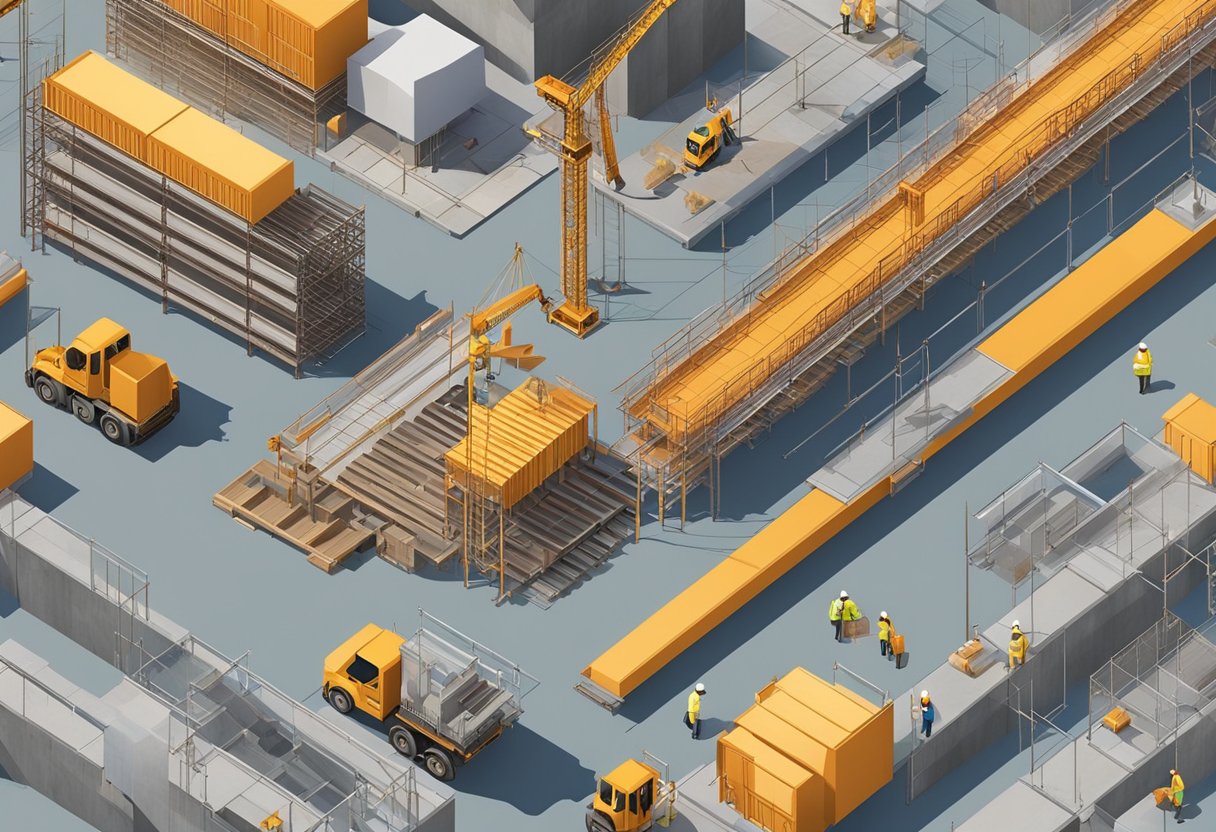Types Of Construction
Construction is a crucial element of modern society, providing the buildings and infrastructure that we rely on every day. The construction industry encompasses a wide range of materials, methods, and techniques, each with its own unique benefits and drawbacks. Understanding the different types of construction is essential for anyone involved in the industry, from architects and engineers to contractors and builders.
There are many different types of construction, each with its own specific characteristics and requirements. Some of the most common types of construction include fire-resistive, wood-frame, and steel-frame construction. Each of these types of construction has its own unique set of benefits and drawbacks, and the choice of construction type will depend on a number of factors, including the building’s intended use, location, and budget.
Key Takeaways:
- There are many different types of construction, each with its own unique characteristics and requirements.
- The choice of construction type will depend on a number of factors, including the building’s intended use, location, and budget.
- Understanding the different types of construction is essential for anyone involved in the construction industry.
Construction Materials and Methods

Construction materials and methods are used to create buildings, structures, and infrastructure. The chosen materials and methods can have a significant impact on the durability, safety, and cost of the construction project. In this section, we will explore some of the common materials and methods used in construction.
Concrete and Steel Usage
Concrete and steel are two of the most commonly used materials in construction. Concrete is a composite material made up of cement, water, and aggregates such as sand, gravel, or crushed stone. Steel is an alloy made up primarily of iron with small amounts of carbon and other elements.
Concrete is often used for its durability and strength, while steel is used for its strength and flexibility. These materials are often used in combination to create structures such as bridges, high-rise buildings, and other large-scale projects.
Wood and Combustible Materials
Wood and other combustible materials are commonly used in construction for their ease of use and affordability. However, these materials come with a risk of fire and can contribute to the spread of flames.
Wood is often used for residential construction, including framing, flooring, and roofing. Other combustible materials such as insulation and drywall are also commonly used.
Non-Combustible and Fire-Resistant Materials
Non-combustible and fire-resistant materials are used in construction to increase safety and reduce the risk of fire. These materials include concrete, steel, and other materials that do not burn or contribute to the spread of flames.
Fire-resistant materials are designed to withstand exposure to high temperatures and flames without breaking down or igniting. These materials are often used in areas where fire safety is a concern, such as stairwells, fire escapes, and other emergency exits.
In conclusion, the choice of construction materials and methods can have a significant impact on the safety, durability, and cost of a construction project. It is important to carefully consider the advantages and disadvantages of each material and method before making a decision.
Types of Construction
When it comes to building construction, there are five types of construction that are classified based on the materials used and the level of fire resistance they provide. These five types of construction are Type I: Fire-Resistive, Type II: Non-Combustible, Type III: Ordinary, Type IV: Heavy Timber, and Type V: Wood Frame.
Type I: Fire-Resistive
Type I construction is also known as fire-resistive construction. This type of construction is designed to withstand fire and prevent it from spreading. Buildings made with Type I construction are typically high-rise buildings made of concrete and protected steel. The fire-resistance rating of Type I construction is the highest, and it can withstand fire for up to four hours.
Type II: Non-Combustible
Type II construction is also known as non-combustible construction. This type of construction is used in newer buildings with tilt-slab or reinforced masonry walls and a metal roof. The walls of Type II construction are made of non-combustible materials such as concrete, brick, or stone. The fire-resistance rating of Type II construction is lower than Type I, and it can withstand fire for up to two hours.
Type III: Ordinary
Type III construction is also known as ordinary construction. This type of construction is used in both new and old buildings with non-combustible walls but a wood-framed roof. The walls of Type III construction are made of non-combustible materials, while the roof is made of wood. The fire-resistance rating of Type III construction is lower than Type II, and it can withstand fire for up to one hour.
Type IV: Heavy Timber
Type IV construction is also known as heavy timber construction. This type of construction is used in older buildings made from thick lumber. The walls of Type IV construction are made of non-combustible materials, while the roof and floors are made of heavy timber. The fire-resistance rating of Type IV construction is lower than Type III, and it can withstand fire for up to one hour.
Type V: Wood Frame
Type V construction is also known as wood frame construction. This type of construction is used in residential buildings and small commercial buildings. The walls and roof of Type V construction are made of wood. The fire-resistance rating of Type V construction is the lowest, and it can withstand fire for up to 30 minutes.
In conclusion, understanding the different types of construction is important when designing and building a structure. The type of construction used will depend on factors such as the intended use of the building, the materials available, and the level of fire resistance required.
Building Types and Uses
When it comes to construction, buildings and structures are classified into different types based on their design, materials, and intended use. These classifications are important for determining the appropriate building codes and regulations that must be followed during construction. In this section, we will explore the different types of buildings and their uses.
Residential Buildings
Residential buildings are structures that are designed for people to live in. They can be single-family homes, apartments, or condominiums. Residential construction can be made of wood, concrete, or steel, depending on the design and location of the building. The primary goal of residential construction is to provide a safe and comfortable living environment for the occupants.
Commercial and Industrial Buildings
Commercial and industrial buildings are structures that are designed for business purposes. They can include office buildings, shopping malls, warehouses, factories, and other similar structures. Commercial and industrial construction requires a different set of building codes and regulations than residential construction. These buildings must be designed to accommodate heavy equipment, large numbers of people, and other specialized needs.
Institutional and Infrastructure Projects
Institutional and infrastructure projects are structures that are designed for public use. They can include schools, hospitals, libraries, government buildings, and other similar structures. Infrastructure projects can include bridges, highways, airports, and other similar structures. These types of construction projects require specialized knowledge and expertise to ensure that they meet the needs of the public and are built to last.
In conclusion, understanding the different types of construction and their uses is important for ensuring that buildings and structures are built to meet their intended purpose. Whether it is residential, commercial, industrial, or institutional construction, each type requires specialized knowledge and expertise to ensure that it meets the needs of the occupants and the public.
Construction Process and Participants
When it comes to construction projects, there are a variety of participants involved in the process. These individuals and organizations play different roles and have varying responsibilities throughout the planning, design, and construction phases. Understanding the roles and responsibilities of each participant is crucial to ensuring the success of the project.
Planning and Design
The planning and design phase of a construction project is where the foundation for the entire project is laid. This phase involves architects, engineers, and other professionals who work together to create a plan for the project. During this phase, the team will determine the scope of the project, create a budget, and develop a timeline for completion. They will also work to ensure that the project meets all relevant regulations and standards.
Construction Phases
Once the planning and design phase is complete, the construction phase can begin. This phase involves a variety of participants, including contractors, builders, and laborers. The construction phase is where the project comes to life, as the various structural elements are assembled and the building takes shape.
Roles and Responsibilities
Each participant in a construction project has specific roles and responsibilities. Architects and engineers are responsible for designing the project and ensuring that it meets all relevant regulations and standards. Contractors are responsible for overseeing the construction process, managing the budget, and ensuring that the project is completed on time. Builders and laborers are responsible for actually constructing the building, following the plans and specifications provided by the architects and engineers.
The owner of the project is ultimately responsible for ensuring that the project is completed successfully. They will work closely with the other participants to ensure that the project is completed on time, within budget, and to the desired specifications. They will also be responsible for ensuring that all relevant regulations and standards are met throughout the project.
In conclusion, the construction process involves a variety of participants who all play important roles in the success of the project. By understanding the roles and responsibilities of each participant, it is possible to ensure that the project is completed successfully and meets all relevant regulations and standards.
Building Codes and Compliance
Building codes are a set of regulations that define the minimum requirements for the design, construction, and maintenance of buildings. Compliance with building codes is crucial to ensure the safety and durability of structures, as well as to prevent collapse due to natural disasters or other hazards.
International Building Code (IBC)
The International Building Code (IBC) is one of the most widely used building codes in the United States. It provides a comprehensive set of regulations for the design, construction, and maintenance of buildings, including guidelines for fire safety, energy efficiency, and structural standards.
The IBC establishes five types of construction, from Type I (fire resistive) to Type V (wood frame), based on the materials used in the building’s construction. Each type of construction has specific requirements for fire resistance, structural integrity, and durability, among other factors.
Fire Safety and Structural Standards
Fire safety and structural standards are critical components of building codes. They ensure that buildings are constructed to withstand the effects of fire and other hazards, such as earthquakes or high winds.
Fire safety standards typically include requirements for fire resistance, fire protection systems (such as sprinklers and alarms), and means of egress (exit routes). Structural standards focus on the strength and stability of the building’s components, such as walls, floors, and roofs.
Compliance with these standards is essential to ensure the safety and well-being of building occupants, as well as to prevent property damage and loss of life in the event of a disaster. Building owners and contractors must adhere to these standards to ensure that their structures are safe and durable.






